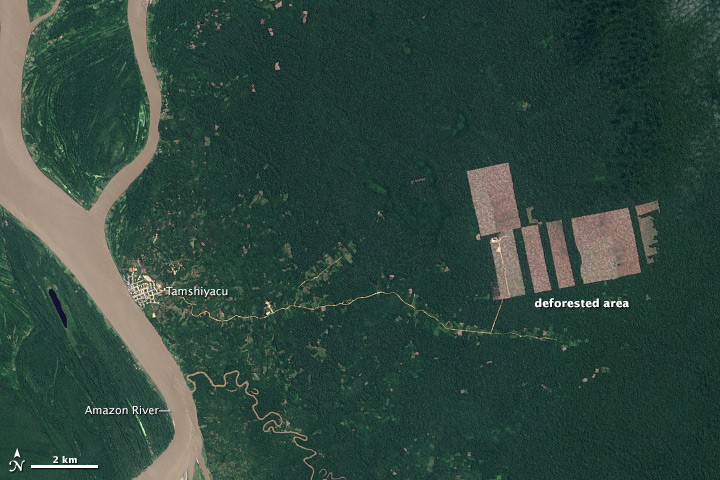
acquired August 28, 2013
download large image (7 MB, JPEG, 4572x4572)

acquired October 5, 2012
download large image (5 MB, JPEG, 4572x4572)
acquired October 5, 2012 - August 28, 2013
download Google Earth file (KML)
Tropical forests are threatened by
many types of farming, ranching, and human activity. One of the best
ways to track those threats is through the Landsat series of satellites,
developed by NASA and operated by the U.S. Geological Survey.
The accessible and free archive of Landsat data makes it possible for
scientists to monitor changes in remote landscapes without leaving their
offices and labs.
Remote sensing scientist Clinton Jenkins
of North Carolina State University had just such an opportunity earlier
this year. In July 2013, he received a tip from colleagues in South
America about some possible deforestation in the Loreto region of Peru.
Jenkins and colleagues then began combing through recently acquired Landsat images
for signs of change. Within hours, they found an image with what
appeared to be bare ground in previously intact forest east of
Tamshiyacu, Peru. But the image was cloudy, a problem for remote sensing of most tropical regions in daylight.
So the researchers waited. Every eight days, either Landsat 7 or Landsat 8
passed over the region, and every eight days, they got another cloudy
image with hints but no confirmation of cleared forest. Finally on
August 28, 2013, Landsat 8 got a clear view of the area. The top image
above, from the Operational Land Imager
on Landsat 8, shows the extent of the new deforestation. The lower
image, from the Enhanced Thematic Mapper Plus on Landsat 7, shows the
same area on October 5, 2012.
“Landsat imagery is essential for environmental monitoring because it
is free, easy to access, and quickly available after the satellite
passes over an area,” said Jenkins, who has been studying deforestation
since he was a graduate student. “Satellites are the only way to monitor
these areas because they are so large and so difficult to access.”
By piecing together evidence from multiple Landsat 7 and 8 images,
Jenkins and colleagues have estimated a deforestation rate of roughly
100 hectares (247 acres) per week in the tract they observed. As of
early September 2013, at least one thousand hectares were cleared near
Tamshiyacu, according to Jenkins. Using a NASA-funded dataset on
tropical biomass, he estimated that 300,000 tons of biomass were cut
down, equal to 150,000 tons of carbon emitted to the atmosphere.
Scientists are continuing to monitor the area by satellite, but cloud
cover continues to be a problem.
Across Amazonia, as well as tropical Asia, one of the newest threats
to forests is the clearing of land for palm oil plantations. The
production of oil palm has been dominated by Indonesia and Malaysia,
where vast tracts of palm trees have replaced much of the native forest in recent decades, often through burning. With such deforestation now escalating in the Amazon, scientists are concerned about the impact on biodiversity and on the planet’s carbon budget.
“Without the Landsat archive, there is simply no way we could have
documented this deforestation fast enough to have any chance of stopping
it,” Jenkins said. “Delayed access could mean thousands of hectares of
forest destroyed, largely unseen, until it is too late.”
“Tracking forest disturbance, particularly tropical deforestation, is one of the landmark applications
of Landsat data,” said Jim Irons, NASA’s project scientist for the
Landsat program. “Through the archive and its open data policy, the
evidence of forest disturbance is transparent, unbiased, conclusive, and
available to all.”
References and Further Reading
- Baccini, A., et al (2012) Estimated carbon dioxide emissions from tropical deforestation improved by carbon-density maps. Nature Climate Change 2 (2012) 182–185.
- Gutiérrez-Vélez, V.H. et al (2011) High-yield oil palm expansion spares land at expense of forests in the Peruvian Amazon. Environmental Research Letters (6) 044029.
- Koh, L.P. and Wilcove, D.S. (2008) Is oil palm agriculture really destroying tropical biodiversity? Conservation Letters Volume 1, Issue 2, 60-64.
- La Region (2013, September 2) Hemos constatado que hay una deforestación masiva en Tamshiyacu. Accessed September 16, 2013.
- NASA Earth Observatory World of Change: Amazon Deforestation.
- NASA Earth Observatory (2012, July 23) Landsat Looks and Sees.
- NASA Earth Observatory (2012, January 9) Seeing the Forests for the Trees and the Carbon.
- NASA Earth Observatory (2007, March 30) Tropical Deforestation.
NASA Earth Observatory images by Jesse Allen and Robert Simmon, using Landsat 8 data from the USGS Earth Explorer. Caption by Mike Carlowicz, NASA Earth Observatory.
- Instrument:
- Landsat 8 - OLI
NASA: Peru - Landsat 8 Detects New Deforestation - 11.19.13 - It is happening now - Esta sucediendo ahora
Ricardo M Marcenaro - Facebook
Blogs of The Solitary Dog:
Solitary Dog Sculptor:
http://byricardomarcenaro.blogspot.com
Solitary Dog Sculptor I:
http://byricardomarcenaroi.blogspot.com
Para:
comunicarse conmigo,
enviar materiales para publicar,
propuestas comerciales:
marcenaroescultor@gmail.com
For:
contact me,
submit materials for publication,
commercial proposals:
marcenaroescultor@gmail.com
Diario La Nación
Argentina
Cuenta Comentarista en el Foro:
Capiscum
My blogs are an open house to all cultures, religions and countries. Be a follower if you like it, with this action you are building a new culture of tolerance, open mind and heart for peace, love and human respect.
Thanks :)
Mis blogs son una casa abierta a todas las culturas, religiones y países. Se un seguidor si quieres, con esta acción usted está construyendo una nueva cultura de la tolerancia, la mente y el corazón abiertos para la paz, el amor y el respeto humano.
Gracias :)

No hay comentarios:
Publicar un comentario